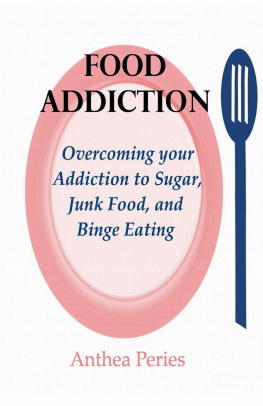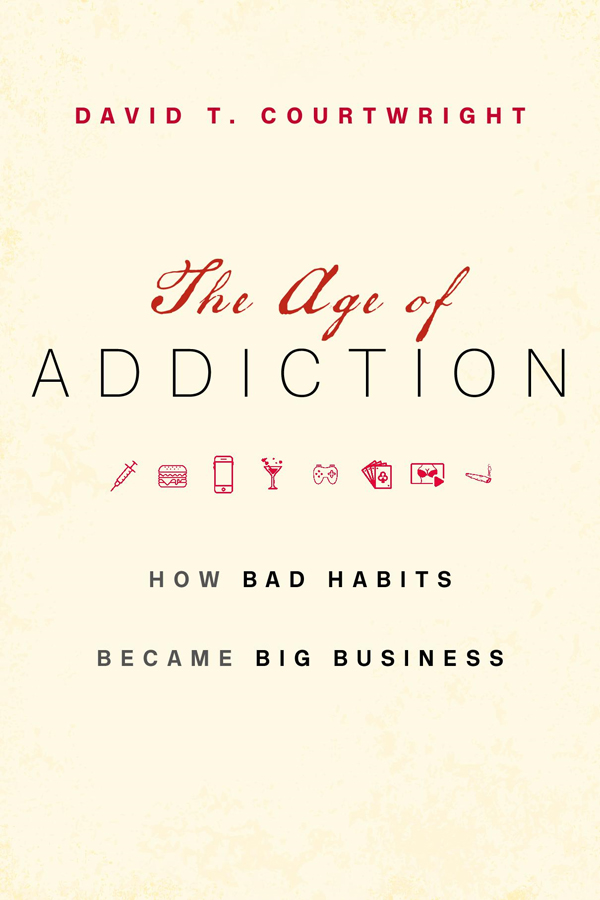9780674737372 (alk. paper)
Names: Courtwright, David T., 1952 author.
Title: The age of addiction : how bad habits became big business / David T. Courtwright.
Description: Cambridge, Massachusetts : The Belknap Press of Harvard University Press, 2019. | Includes bibliographical references and index.
Subjects: LCSH: Compulsive behavior. | CapitalismPsychological aspects. | CapitalismMoral and ethical aspects. | Hedonism. | AdvertisingPsychological aspects. | Psychology, Pathological.
ONE SUMMER DAY in 2010 a Swedish graduate student named Daniel Berg approached me after a talk I gave at Christs College, Cambridge. During the talk I had casually mentioned internet addiction. Berg told me that I had spoken a truth larger than I knew. Many of his male friends at Stockholm University had dropped out of school and were living in crash pads, compulsively playing World of Warcraft. They spoke an argot more English than Swedish. It was all raiding, all the time.
How do they feel about their circumstances? I asked.
They feel angst, Berg said.
But they keep playing?
They keep playing.
This sort of behavior does seem like an addiction, in the sense of a compulsive, regret-filled pursuit of transient pleasures that are harmful to both the individual and society. For gaming, the personal cost was highest for Swedish men. I am, Berg reported, now the only male in my graduate program in economic history.
Back home in Florida I noticed digital distractions exacting a more impartial academic toll. The smartphones that dotted the lecture halls were as often wielded by women as by men. But when I told Bergs tale to my students, they instantly recognized the type. One admitted that he had lost a year to compulsive gaming. He said that he was in recoveryprecariously, to judge by his grades. Another student knew gamers who kept cans by their computers. They used them to avoid having to take bathroom breaks.
The can by the computer became for me a symbol of the shifting meaning of addiction. As late as the 1970s the word seldom referred to anything other than compulsive drug use. Over the next forty years, however, the concept of addiction broadened. Memoirists confessed to addictions to gambling, sex, shopping, and carbs. German sex therapists called internet porn a gateway drug that ensnared the young. A New York Times op-ed declared sugar to be addictive, literally, in the same way as drugs. A toothless young New Zealand mother drank up to ten liters of Coke a day, then splashed the headlines when she died of coronary arrhythmia. A nineteen-year-old truant in Jiangsu Province made the news when he hacked off his left hand to cure his internet addiction. Chinese officials judged as many as 14 percent of his peers to be similarly hooked, and set up internet addiction rehabilitation camps. South Korea and Japan followed suit. Taiwanese legislators voted to fine parents who let their children spend too much time online, updating a law forbidding minors smoking, drinking, drug-taking, and betel-chewing. Only the last habit failed to appeal to Americans, 47 percent of whom showed signs of at least one behavioral or substance addiction disorder in any given year in the early 2000s.
Often they showed signs of more than one. Medical researchers have discovered that substance and behavioral addictions have similar natural histories. They produce similar brain changes; similar patterns of tolerance; and similar experiences of craving, intoxication, and withdrawal. And they reveal similar genetic tendencies toward similar personality disorders and compulsions. The manic gambler and the casino barfly are apt to be one and the same. In 2013 the new edition of the bible of psychiatry, the Diagnostic and Statistical Manual of Mental Disorders: DSM-5, described gambling disorders in language indistinguishable from drug addiction. The editors ushered internet gaming disorder into the green room of addiction by designating it a condition for further study. In 2018 the WHO made it official by adding gaming disorder to the revised International Classification of Diseases.
Not everyone was happy with all the talk of addiction. Clinicians avoided it for fear of discouraging or stigmatizing patients. Libertarians dismissed it as an excuse for lack of discipline. Social scientists attacked it as medical imperialism. Philosophers detected equivocation, the misleading practice of using the same word to describe different things. I mean to give these critics a hearing. For now, though, I will stick to addiction. The word provides a usefully concise and universally understood way of referring to a pattern of compulsive, conditioned, relapse-prone, and harmful behavior. The important job, and the goal of this book, is to explain why that pattern of harmful behavior has become more conspicuous and varied over time.
A GOOD PLACE TO BEGIN is to review what we know about addictions. They begin as journeys, usually unplanned, toward a harmful endpoint on a spectrum of consumption. The journey can be rapid, or slow, or interrupted. Casual indulgence, even of a drug like heroin, does not always lead to addiction. When it does, the condition is not necessarily permanent. Addicts can and do quit, either permanently or for long stretches of time. Nor is all excessive consumption necessarily addiction. People can gamble too much without being compulsive, just as they can burden their scales without being food addicts. Yetand this is the crucial pointregular, heavy consumption has a way of shading into addiction, as when a steady drinkers craving intensifies, erupting into full-blown alcoholism. An addiction is a habit that has become a very bad habit, in the sense of being strong, preoccupying, and damaging, both to oneself and to others. The type of damage depends on the substance or behavior. Compulsive gamers may ruin their scholastic and marital prospects. They do not ruin their livers or lungs.
The addiction process is social as well as biological. Conditions like stress and peer behavior help tip individuals into addiction, though the process ultimately manifests itself in their brains. Frequent resort to alcohol, drugs, and drug-like behaviors causes changes in neurons, including altered gene expression. Over time these changes occur in more and larger regions of the central nervous system, like drops of dye spreading on a taut sheet. The changes are long-lasting, particularly in developing brains. The earlier children and adolescents experience an addictive substance or pastime, the likelier they are to retain, even when abstaining, a powerful emotional memory of the behavior that once made them feel so good.












